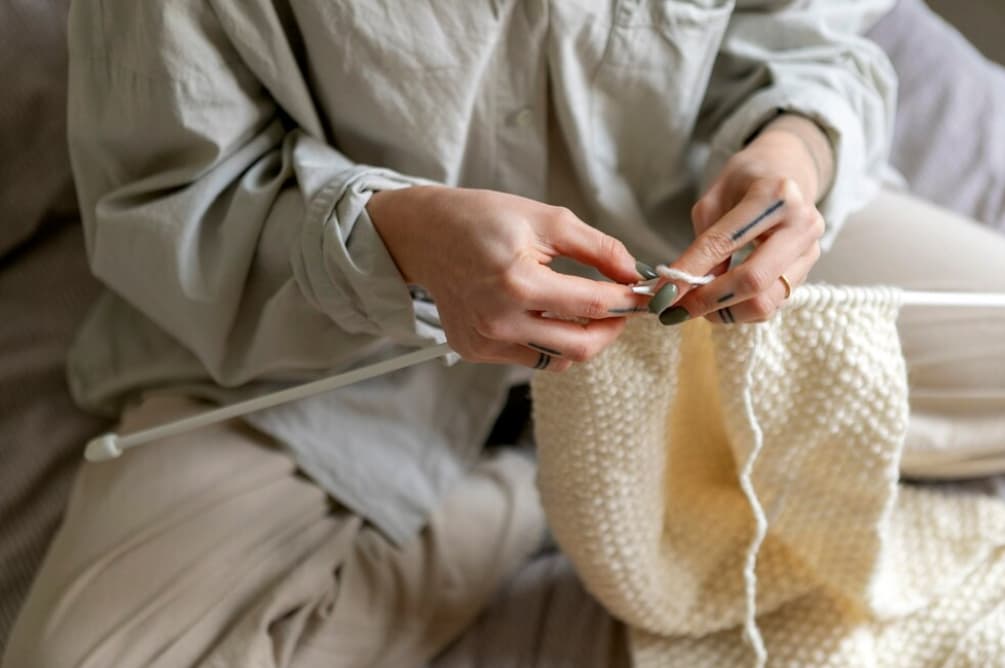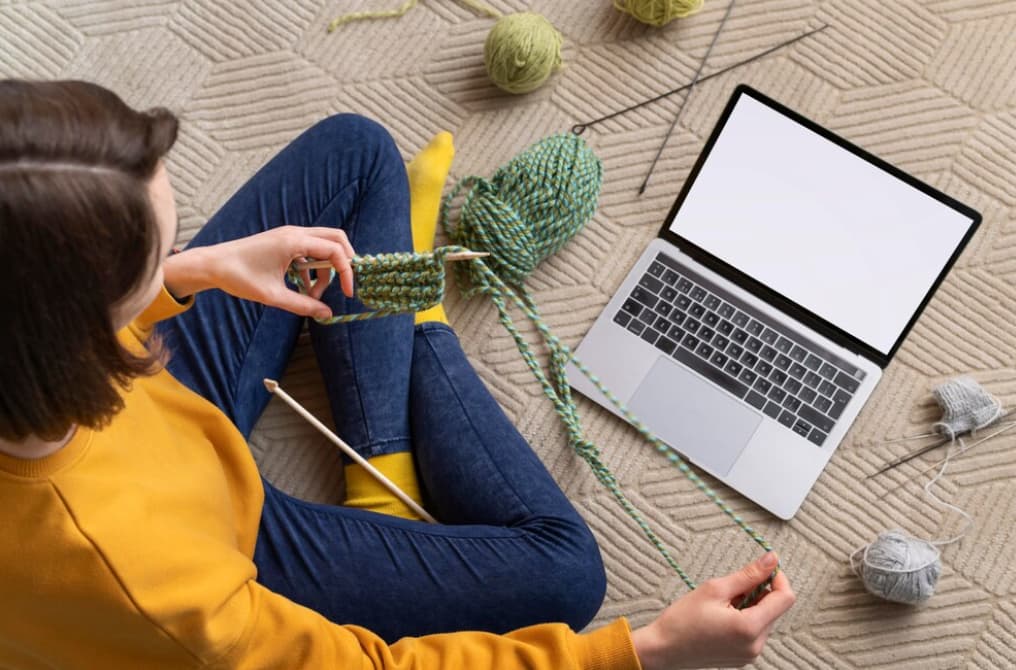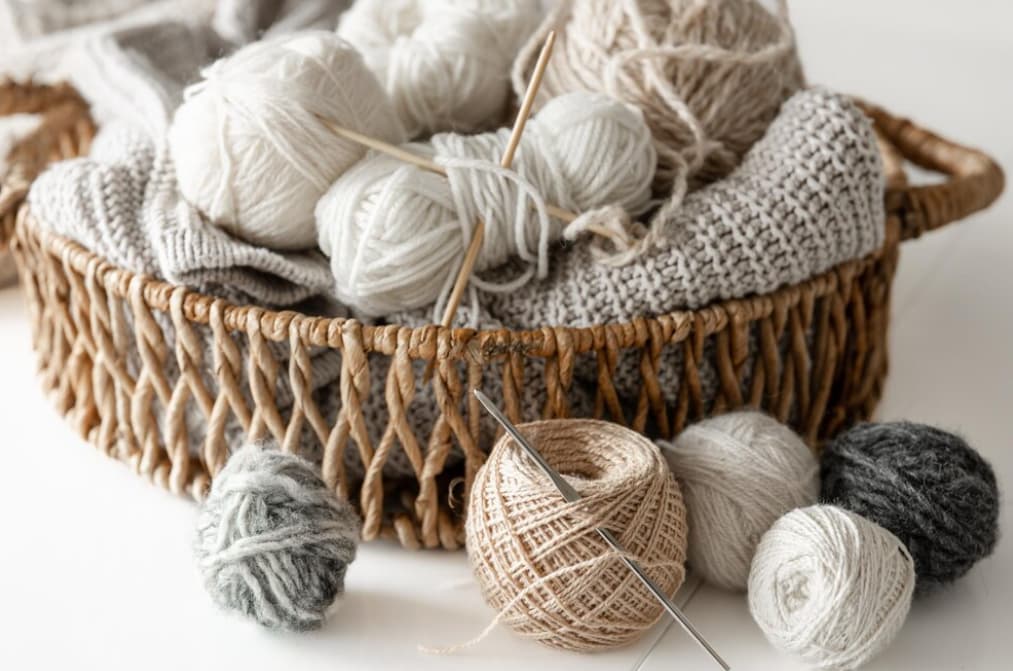Knitting vs. Crochet: Choose Your Craft
Is knitting or crocheting easier? A closer examination of the facts, the advantages, and the disadvantages of each craft. Interested in creating your own sweaters, scarves, socks, toys, or blankets? Or searching for a soothing and budget-friendly hobby with purportedly calming and meditative qualities? Curious about the distinctions between knitting and crochet?
Let’s lead you through the merits and drawbacks of each craft. You might be pondering which of the two is simpler for novices and which pastime suits you better. This post will address these queries and highlight a few facts that may not yet be acquainted with. The focus will be on identifying the commonalities between knitting and crochet, as it is believed that these crafts share more similarities than differences.
For those interested in handcrafted textiles, comparing knitting and crochet can be intriguing, especially in projects like knitting socks. You may also like an article focused on the specifics of knitting socks.
A Comparison of Knitting and Crocheting
Ravelry and Etsy stand out as the top destinations for exploring patterns. A quick observation reveals that there isn’t a single garment, toy, or household item, such as blankets or sweaters, that can’t be crafted using either technique.
In the selection between the two, it is essential to recognize that neither imposes restrictions on your creativity or available options. What distinguishes them is the resulting fabric and the relative simplicity or complexity of specific constructions. Let’s examine this more closely:
Knitting and Crocheting Techniques and Tools
Knitting involves the use of two needles, employing both hands. Essentially, one needle holds loops while the other retrieves a new row of loops from this foundation. Initially, this demands substantial muscle memory and dexterity, especially as all stitches can potentially unravel or slip off the sharp, slick needles.
Knitting patterns often necessitate various methods and additional tools for shaping fabric, putting stitches on hold, or picking up stitches. Crafting three-dimensional objects can be particularly challenging and may require a complete set of five double-pointed knitting needles.
On the other hand, crocheting employs only a single hook and a primary hand to form the fabric. While both crafts entail pulling yarn through loops, the hook greatly simplifies this process. Moreover, the resulting stitches are secure (essentially forming a chain of knots), with only the presently active stitch susceptible to unraveling.
This inherent stability in crocheting makes correcting errors as simple as pulling the yarn to unravel a few stitches, while knitting demands more expertise (and sometimes a crochet hook) for error correction. Additionally, even for intricate patterns, crocheting typically doesn’t necessitate any extra tools.
Fabric Differences in Knitting and Crocheting
In contemporary retail stores, most garments available are knitted, even if they don’t appear to be. Items like T-shirts, sweaters, socks, and undergarments are commonly crafted from jersey, a finely machine-knit fabric.
- Knitting is often associated with garments, offering an extensive array of hand-knitting patterns. If you’re seeking diverse garment options, crochet may not meet your expectations (for example, Ravelry lists 150,000 knitted sweater patterns compared to only 16,000 crochet sweaters). Knitting patterns follow a logical structure since the fabric is exclusively constructed from loops (stitches) on the needles. This simplicity lends itself well to creating uniform, smooth fabric like rectangles or tubes, although it can be challenging for more intricate structures. However, knitting does excel in intricate colorwork;
- Conversely, crochet primarily forms stitches by penetrating previous rows, resulting in thicker and more textured fabric with decorative holes. It typically consumes more yarn compared to knitting and offers less stretchiness, as adjacent stitches are not directly connected. When it comes to garments, crochet fabric is often associated with vintage doilies or whimsical bralettes. Its denser nature allows it to support 3-dimensional forms like toys or home decor more effectively.
It’s worth noting that knitting fabric’s popularity is partly due to the absence of large-scale crochet machines, making mass production of crochet fabric economically unfeasible. If you find crocheted items for sale, they are likely handmade, adding to their unique appeal.

The Ease of Knitting Versus Crocheting
When comparing the ease of crocheting and knitting, crocheting often appears more straightforward. It demands slightly less dexterity and multitasking, potentially making it more accessible for beginners. In knitting, managing multiple live stitches and rectifying errors can pose challenges for novices. Additionally, crochet stitches are generally larger than knitting stitches, allowing for quicker creation of similar surface areas, albeit at the expense of increased yarn usage.
Knitting often involves distinguishing between the right and wrong sides of the work, a distinction less crucial in crocheting. This simplicity makes crocheting potentially more suitable for young children under eight years or adults with limited fine motor skills. Initially, using a hook to pull a loop through another in crocheting can be simpler and less frustrating compared to knitting, where stitches can easily slip off the needles due to the absence of a hook.
However, it is crucial to acknowledge that the complexity of advanced projects in both crafts is comparably challenging. This means that the initial learning curve is steeper in knitting, but as one progresses, the difficulty levels between the two crafts converge. Therefore, for those seeking a brief hobby, knitting might initially seem daunting, but with time, the differences in difficulty diminish.
The tools required for each craft also differ. Crocheting primarily requires hooks and yarn, with a modest investment of around 50 USD sufficing for most beginner and intermediate patterns. In contrast, knitting can entail higher costs, especially for quality equipment like interchangeable needles, which alone can exceed 100 USD. This does not include other potentially necessary knitting tools.
It’s worth noting that for beginners, the initial investment for knitting and crocheting can be similar. However, for a diverse range of knitting projects requiring various needles and special tools, costs may increase. Yet, knitting has the advantage of being more yarn-efficient, using about 30% less yarn, which can be a significant factor given that yarn is often the primary cost in these crafts.
Comparing Knitting and Crocheting: Benefits and Drawbacks
Now, let’s consolidate everything into a single comparison table. It’s essential to emphasize that the choice between knitting and crocheting will primarily revolve around your individual preferences. There isn’t a definitive winner in this comparison:
| Things to Consider | Knitting | Crocheting |
|---|---|---|
| Ideal for Projects | Sweaters, socks, hats, shawls, square shapes | Toys, home decor (blankets, doilies, baskets), circular shapes |
| Fabric Characteristics | Drapey, soft, lacy, smooth, delicate, stretchy | Lacy, sturdy, rigid, textured, whimsical/intricate |
| Beginner-Friendly Challenges | Toys and tubular/spherical shapes | Intricate colorwork, drapey, smooth rectangular projects |
| Available Patterns | Large libraries of (free) patterns, books, journals, magazines | Fewer patterns but abundant creative possibilities |
| Project Completion Speed | Initially slower, especially with big needles and chunky yarn | Initially faster due to basic crochet stitches being larger |
| Fixing Mistakes | More complicated to fix mistakes multiple rows below | Simpler to fix basic mistakes, harder to fix mistakes farther down |
| Starting Costs | Approximately $30-50 USD for a decent starter kit | Around $25-40 USD for a decent starter kit |
| Advanced Costs | Requires more tools, but uses 30% less yarn | Requires fewer supplies, but consumes more yarn, which can be costly |
| Seaming | Many intermediate projects involve extensive seaming, allowing precise fitting | Most crochet projects are seamless, easily continuing with a new ball of yarn |
It’s important to emphasize that both crafts are capable of creating identical projects. Crocheting, for example, can produce sweaters, but many individuals prefer the smoother and more drapey appearance of knitted sweaters.
Amigurumi and home decor items can be knitted as well. However, they will exhibit a more delicate appearance, albeit being considerably more challenging to craft. In crochet, toys are considered relatively straightforward beginner projects, whereas knitting may require years of experience to tackle similar creations.
Comparing the Speed of Crochet and Knitting
There is a common belief that crochet is faster than knitting, but this deserves a closer examination. For beginners, crochet might seem quicker due to the simplicity of forming stitches with a hook. In the initial stages, one might find crocheting a certain area faster than knitting the same.
Additionally, crochet allows for stacking multiple stitches (like treble crochet) on top of each other, a feature that enhances its speed. While knitting also has techniques for stacked increases, these are typically more advanced. It is crucial to recognize, however, that these crochet techniques often result in a lacier, more open fabric.
As one progresses, knitting can become significantly faster, especially when utilizing special speed knitting techniques that can lead to forming up to two stitches per second. This speed is challenging to match in crochet, except when counting treble stitches as three. The world’s fastest knitter can create 118 stitches in a minute, a rate not easily achieved in crochet.
Ultimately, both crochet and knitting can be quick, excelling in different aspects and techniques.
Comparing Crochet and Knitting for Blanket Making
The debate over whether to use crochet or knitting for blanket making highlights unique characteristics of each craft. Both methods can produce beautiful blankets, but they have distinct differences. Crochet is renowned for its colorful granny squares, which offer a versatility that is challenging to replicate with knitting. Knitting’s equivalent, mitered squares, lack the same range of options.
In contrast, knitting excels in creating cables. These cables appear crisper in knitting than in crochet, where advanced cable patterns can be more challenging to execute. Similarly, intricate colorwork like intarsia and Fair Isle in knitting allows for detailed designs and pictures, a feature less accessible in crochet.
Another factor is the process of crafting a blanket. Knitting a blanket requires having all stitches, or the full width, on the needles simultaneously, which can amount to 400 stitches or more. Completing a single row may take up to 30 minutes, and pausing mid-row is often not recommended. Conversely, crochet allows for stopping at any point and typically involves constructing a blanket from smaller, individual units.
Knitted afghans can also be made from multiple small squares, but this approach involves extensive seaming and sewing, which some knitters find tedious. In crochet, granny square blankets are often joined as you go, leaving only the ends to be woven in, streamlining the finishing process.
Similarities in Both Craft Forms
While much discussion often revolves around the differences between crochet and knitting, it’s important to recognize the similarities and shared aspects of these crafts. Many knitting techniques, such as provisional cast-ons or certain methods of picking up stitches, require a crochet hook, and the reverse is also true. Exploring both crafts can be beneficial, regardless of which one is initially chosen.
Engaging in either craft allows for the use of beautiful yarns and the opportunity to express individual style, preferences, and personality through each project. Whether it’s knitting or crocheting, these activities support the creation of a sustainable, slow-fashion wardrobe and offer ways to personalize home decor. Both crafts are not just about creating items; they are about the joy and fulfillment found in the process itself.
Choosing Between Crochet and Knitting

Learning to crochet around the age of 4-5 and picking up knitting a few months later can be a common experience. Initially, crafting small bags, toys, and various items through crocheting can be quite engaging. The simplicity and speed of creating even intricate patterns are often appealing aspects of this craft.
As time progresses, these skills might become part of school curricula. However, some may find that the texture produced by crochet doesn’t align with their aesthetic preferences, appearing somewhat outdated or lacking in delicacy and smoothness.
Knitting, particularly projects like socks and elaborate home decor items such as flowers and mushrooms, can be more satisfying for some. While proficient in crocheting, the results might not always meet their expectations. Crochet amigurumi, for instance, can seem too simplistic or cartoon-like for certain tastes, even though this style is popular among many enthusiasts.
It’s important to note that preference for knitting over crocheting isn’t a universal recommendation, especially on platforms primarily dedicated to knitting. The emphasis is on personal choice, often shared towards the end of discussions or articles rather than at the beginning.
For those exploring these crafts, it’s recommended to consider the types of projects desired, like sweaters, toys, or blankets, and then research crochet and knitting patterns on platforms like Google or Pinterest. One of these crafts might resonate more strongly.
Moreover, learning both crafts isn’t mutually exclusive. Exploring the synergies between crocheting and knitting can be beneficial. For example, combining knitting and crochet in projects, like adding a delicate crochet border to a knitted blanket or a crochet cuff to knitted socks, can produce stunning results.
Conclusion
Both knitting and crochet have their unique charm, offering a myriad of creative possibilities. Deciding which craft to pursue doesn’t mean forsaking the other entirely. Both crafts together can enable a wider scope of creativity. Embrace the strengths of each craft, be it the finesse of knitted garments or the structural flexibility of crochet. The choice ultimately lies in personal preference and the type of project one wishes to undertake. Whichever path is chosen, remember – the joy of crafting lies in the journey as much as the final product.
